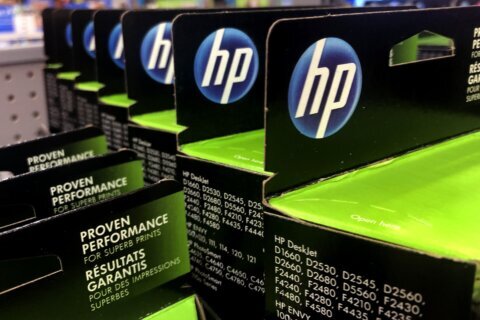A wide variety of everyday, essential devices and practices still used today have roots in the nation’s capital. Innovations such as the first message sent by telegraph, the first-ever instance of long-distance wireless communication of sound, the first clock made in America and even the football huddle come from D.C.
Becky Oakes, the historian at the U.S. Patent and Trademark Office, shared with WTOP her picks for a few of the most essential inventions that were created by D.C.-based inventors. The genius, ingenuity and influence of these people and their works can still be found in places such as hospitals, hotels and homes.
Listed in chronological order, here are five inventions created by local pioneers whose creations are still influential today.
Miriam Benjamin’s gong and signal chair
South Carolina-born Miriam Benjamin was an African American educator and public servant who moved to the District as an adult around the turn of the 20th century. While working as a government clerk, she filed a patent for her gong and signal chair in 1888 for use in hotels.
Her invention was designed to allow hotel patrons to call for assistance while remaining seated, reducing the need for servers and attendants.
Oakes told WTOP this was a precursor to a system that was later used by the U.S. House of Representatives and also served as a precursor to what flight attendants use on airplanes today.
“There’s no record of her receiving a formal legal education. So, she likely learned about patent law through informal means,” Oakes said. “She was a trailblazer as both an inventor and a practicer of patent law.”
Marvin Stone’s drinking straw
Before Marvin Stone, drinking straws were primarily made of natural materials like rye grass. This led to the drinking instruments of the time to have distinctive tastes and a lack of structural integrity, breaking down while in use.
Thanks to Stone’s 1888 patent, straws thereafter were designed with paper and contained a waterproof material like paraffin wax.
Stone was an Ohio-born Civil War veteran who was injured during the Battle of Lookout Mountain. He later moved to D.C. and worked as a journalist before moving into manufacturing.
“He actually opened the factory initially to produce paper cigarette holders. So, it was possible that he was looking to diversify the products produced by the factory,” Oakes said. The success of his straw patent ended up causing his factory to eventually produce more straws than cigarette holders.
Charles Drew’s blood banking
Charles Drew, who was born in D.C. in 1904, was a surgeon and educator who is known as the “Father of the Blood Bank.” He’s highly regarded for his work in blood banking and blood plasma preservation with techniques that were eventually adapted by the American Red Cross.
Oakes told WTOP that he was “integral” to adapting the process that is used for blood banking today. It was his idea to use refrigerated trucks, or “bloodmobiles,” to serve as mobile blood collecting units.
During World War II from September 1940 to January 1941, he was the medical director for the Blood for Britain Project, supervising shipments of sterile, stable blood plasma to Europe for soldiers. In 1941, he also served as medical director of New York City’s Red Cross Blood Bank, the nation’s first large-scale blood bank.
Even with all this, though, “Drew saw his life’s work as not necessarily in blood banking,” according to Oakes, “but in educating the next generation of surgeons.”
As Chief of Surgery at Howard University Medical School, he advanced the next generation of surgeons at the historically Black university, effectively training over half the African American surgeons certified by the American Board of surgery from 1941 to 1950.
In 1940, he became the first African American to earn a doctorate of medical science from Columbia University. The National Association for the Advancement of Colored People also gave him its highest award, the Spingarn Medal, in 1944.
Drew was inducted into the National Inventors Hall of Fame in 2015.
Mary Kenner’s precursor to the maxi pad
Mary Kenner’s sanitary belt was the first sanitary product to contain an adhesive that kept moisture-proof napkins in place during a woman’s period. Before Kenner’s invention, women were mostly using rags and cloth or rubber underwear, according to Oakes.
“This invention kind of took existing materials and made them more efficient and functional for women,” Oakes said.
Even after receiving her patent in 1959, Kenner’s invention never went into production. Oakes attributes this to manufacturers withdrawing their support when they learned that she was a Black woman.
“She didn’t have the funds to manufacture [it] herself, and getting a bank loan was very challenging for a Black woman at the time. But she was undeterred,” said Oakes, who added Kenner also invented other products such as a hands-free backwasher that could be mounted to a shower wall for those with mobility challenges.
Having lived in the District for most of her life, Kenner worked as both a government employee at the U.S. Census Bureau and as a florist. She was born in North Carolina in 1912.
Robert Ledley’s CT scanner
Over the course of his career, Robert Ledley held over 60 patents, but one of his most influential was his whole-body CT machine in 1973. This machine, which he called the automatic computerized transverse axial scanner, allowed health care professionals to generate — in greater detail than before — three-dimensional, cross-sectional reconstructions of internal organs as well as view the body’s soft tissue.
CT technology was originally formulated several years earlier by scientists Godfrey N. Hounsfield and Allan M. Cormack, as reported by The Washington Post. But it was Ledley’s version that revolutionized diagnostics for cancer, heart disease and other major areas of medicine. The prototype now lives at the Smithsonian Institution’s National Museum of American History.
Ledley was born in New York City in 1926 and later joined Georgetown in 1970. He taught at the National Institute of Standards and Technology, Johns Hopkins University and George Washington University. He originally studied dentistry, but eventually earned a master’s degree in theoretical physics.
Ledley was inducted into the National Inventors Hall of Fame in 1990, and seven years later, he received the National Medal of Technology.
Get breaking news and daily headlines delivered to your email inbox by signing up here.
© 2024 WTOP. All Rights Reserved. This website is not intended for users located within the European Economic Area.








